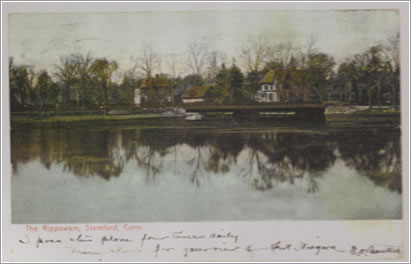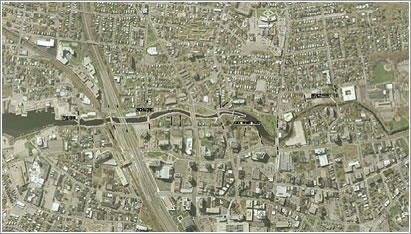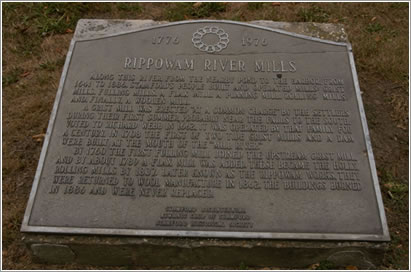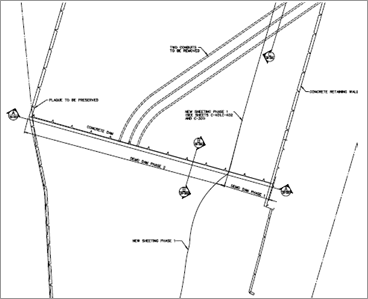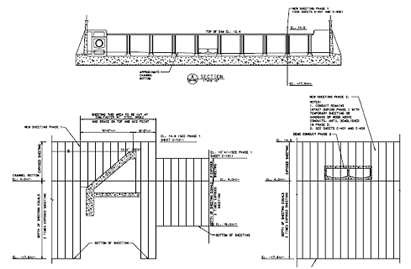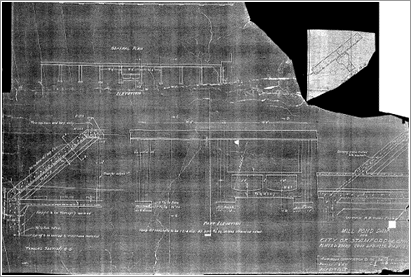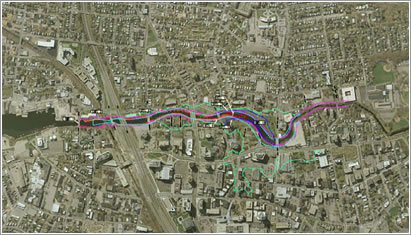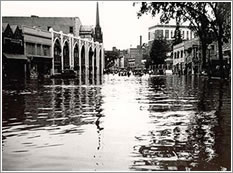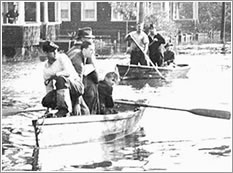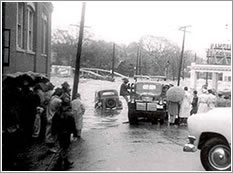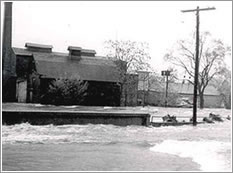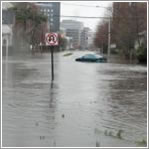Stamford Mill River Corridor River Restoration, Park & Open Space Project
Summary
|
|||||||||||||||||||||||||||||
stretch of the river and a new common ground for the Downtown and West Side communities. The greenway will offer residents and downtown workers an accessible combination of recreation and interaction with nature. The Mill River Collaborative has been established to help manage and develop the park.
As the Rippowam River enters its last reach before the Stamford Harbor, it slows into the impounded Mill Pond, spills over the historic dam above Main Street. The lower reaches of the Rippowam came to be known as the Mill River over the years. The Rippowam River watershed drains 37.5 square miles that extend from just north of the New York line to Long Island Sound. Approximately 75% of the Rippowam watershed is in Stamford.
|
|||||||||||||||||||||||||||||
The Mill River and its historic dam served an important function as the source of power for mills, with the first dam and gristmill constructed in 1641. The plaque shown below reads: 1776 to 1976
In 1922, the dam was rebuilt (Ambursen Dam) and the pond encased with walls in order to meet the requirements of an abutting industrial firm, the Diamond Ice Company. The company closed down operations around 1960 (the pond was also an attraction for ice skating. Substantial freezing no longer occurs. |
|||||||||||||||||||||||||||||
The mill site, including the dam, was later sold to the Stamford Housing Authority for public housing. Recently, title to the dam was transferred from the Housing Authority to the City. The dam prevents the passage of anadromous and freshwater fish species, including river herring.
|
|||||||||||||||||||||||||||||
A considerable portion of the land adjacent to the river is impervious and storm drains from adjacent streets drain directly into Mill River. The combination of urban development and structural restrictions to the river, has caused the aquatic habitat of the Mill River to be degraded. The Mill Pond contains an excessive amount of sediment and is shallow and choked with invasive aquatic plants and decomposing organic matter. In other reaches of the river invasive plants have spread and now dominate much of the riparian edge and marsh wetland habitats.
|
|||||||||||||||||||||||||||||
|
|||||||||||||||||||||||||||||
Historically, development along the river had lots facing neighboring streets and with their backs to the river. The riparian banks of the Mill River have been frequently encroached upon by residential backyards, parking lots and buildings. To the west is the predominantly residential West Side neighborhood and to the east a small residential enclave along Clinton Avenue and Stamford’s Downtown. Within one mile of the Mill River reside half of Stamford’s 121,000 residents and the majority of the city’s office work force is within walking distance of the river as is the University of Connecticut at Stamford and the Transportation Center. Downtown Stamford has witnessed considerable development in recent years, in particular new housing. However, no new park/open space has been created for the growing residential, workforce and student population. |
|||||||||||||||||||||||||||||
|
|||||||||||||||||||||||||||||
In the 1940s and 1950s, Junzo Nojima, Stamford resident and immigrant from Japan planted and cultivated the grove of Kwanzan cherry trees that came to be the most recognized symbol of Mill River Park. His single handed gift to the City and its residents earned him a place among the Heroes of Stamford and his story is depicted in a book that can be viewed at the Stamford Historical Society. The Historical Society is the source of many of the historical images shown here. During floods (link to Flooding Along Mill River at end) the river overtops its banks. The limit of the federally designated 100-year flood extends across Washington Boulevard east into the Downtown. In October 1955, a record two-day rainfall caused extensive flooding and property damage in downtown Stamford. Another significant flood event occurred in 1972. In both April and October, 2007, 50-year flood events caused the closing of Washington Boulevard, Stamford’s primary north-south artery, as well as flooding to the north and east. Damage from these floods reached into the millions of dollars. Removal of the dam and planned park landscape changes will reduce the 100-year flood levels in downtown by 3 feet and largely contain such floods within the park south of North Street.
In 1929, Herbert Swan produced Stamford’s first Master Plan that included new open space and parkland along the Mill River. During the 1970s and 1980s a number of flood studies were prepared by the Army Corps of Engineers and State of Connecticut. Among the alternatives recommended was a by-pass tunnel. The city declined to accept these recommendations, due to the negative impacts on the environment and recreation. In 1976, the City issued a report entitled, “Mill Pond.” The report recommended the creation of a riverside park and the dredging of the Mill Pond. In 1979, the City published a report entitled, “The Mill River Greenbelt Study.” This report studied the feasibility of creating a continuous river walk and linear greenbelt. Stamford initiated the implementation of the study by acquiring some land along the river. In 1997, the City hired Sasaki Associates to produce a comprehensive study of the Mill River Corridor. While prior studies had limited their focus to the river and its immediate banks, it was recognized that the river and potential park and open space should be viewed as part of the adjacent urban fabric and planned in conjunction with the development potential of the entire corridor. This eight months study, which included public forums, resulted in the Mill River Corridor Plan. Key project goals included:
The Sasaki Plan recommended that within the Corridor, nineteen (19) acres of new open space were to be added and another seven (7) acres upgraded to create an open space and park system in the heart of Stamford. Following the completion of the Mill River Corridor Plan, Mayor Dannel Malloy instructed the land use boards, Urban Redevelopment Commission and staff to propose implementation tools to bring the Plan’s recommendations into fruition. Over the next several years, the following regulatory tools were put into place:
In 2000, the city contacted the Corps of Engineers requesting that ecosystem-restoration opportunities along the Mill River be studied by the Corps under Section 206, Aquatic Ecosystem Restoration Program. The Corps report, which took three years to complete, evaluated a number of alternative actions based on the following criteria:
The chosen alternative, endorsed by both the Corps and city, consisted of the removal of the dam, concrete retaining walls, contaminated sediment, and the restoration of a natural stream channel, thereby opening up 4.5 miles of riverine habitat to anadromous fish; restoration of one acre of tidal wetlands and riparian habitat restoration along with a contiguous system of trails and outlooks. Restoration design for the Mill River included both traditional hydraulic analysis and a more recent approach called natural channel design (Rosgen, 1996). A further objective was to use bioengineering techniques, wherever possible, to promote bank stabilization with native vegetation. In 2005, Stamford hired the design team led by Olin Partnership to develop the vision for the park into a Master Design Plan and to coordinate with the Army Corps of Engineers and City in the development of detailed plans for the restoration of the river and the creation of the Park.
To date, implementation has consisted of the following:
As in any project of this magnitude and complexity, there are many challenges ahead. At present, the top priority is the river restoration/dam removal project. While the city’s local share of the costs (42%) the federal share is dependent on congressional “earmark” appropriations. In the event that federal funds are not made available, Stamford will have to decide whether to move ahead with municipal funding for this $8.5 million project. |
|||||||||||||||||||||||||||||
|
|||||||||||||||||||||||||||||
|
|||||||||||||||||||||||||||||
